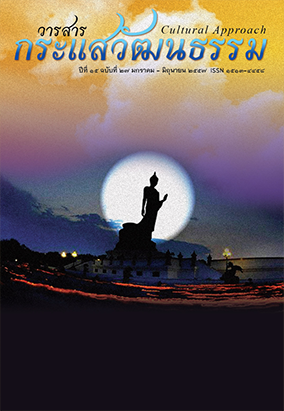ภาพลักษณ์ขนมไทยในสายตาของเยาวชนไทย
Main Article Content
Abstract
บทคัดย่อ
การศึกษาครั้งนี้มีวัตถุประสงค์เพื่อศึกษา ทัศนคติของเยาวชนต่อภาพลักษณ์ขนมไทย
กลุ่มตัวอย่าง คือ เยาวชนไทย อายุ 15-25 ปี ที่อาศัยอยู่ในกรุงเทพมหานคร ใช้วิธีการสุ่มตัวอย่างแบบ
เจาะจง(purposive sampling)ได้ขนาดตัวอย่างจำนวน 455 คน เครื่องมือที่ใช้ในการเก็บรวบรวม
ข้อมูล คือ แบบสอบถาม การวิเคราะห์ข้อมูลใช้สถิติเชิงพรรณนา (Descriptive Statistics)ประกอบ
ด้วย ความถี่ ร้อยละ ค่าเฉลี่ย ค่าเบี่ยงเบนมาตรฐาน และสถิติเชิงอนุมาน(Inferential Statistics)ได้แก่
สถิติ t-test กรณีเปรียบเทียบความแตกต่างของค่าเฉลี่ย 2 กลุ่ม และใช้สถิติ F-test กรณีเปรียบเทียบ
ความแตกต่างของค่าเฉลี่ยมากกว่า 2 กลุ่ม
ผลการศึกษา พบว่า เยาวชนไทยส่วนใหญ่ชื่นชอบขนมไทยที่มีรสหวาน โดยซื้อ 2-5 ครั้งต่อ
เดือนแต่ละครั้งจะซื้อน้อยกว่า 50 บาท และส่วนมากจะซื้อที่ร้านค้าในตลาดสดโดยการแนะนำของ
คนรู้จัก เหตุผลที่เลือกบริโภคขนมไทยเนื่องจากขนมไทยมีรสชาติอร่อย มีกลิ่นหอม รูปแบบบรรจุ
ภัณฑ์มีความสะอาด ปลอดภัย ดูโบราณคลาสสิก และทำจากผลิตภัณฑ์ตามธรรมชาติ ขนมไทย
ที่เยาวชนไทยชอบมากที่สุด คือ ขนมไทยประเภทนึ่ง สำหรับขนมต่างประเทศที่เยาวชนไทยชอบมากที่สุด คือ
ช็อกโกแลต สำหรับทัศนคติของเยาวชนต่อภาพลักษณ์ขนมไทย ผลการวิจัยพบว่า เยาวชนไทยมีทัศนคติที่ดีต่อ
ภาพลักษณ์ขนมไทยทุกด้าน ยกเว้นเรื่องการแสดงป้ายราคาอย่างชัดเจน การส่งเสริมการตลาด และการโฆษณา
ผ่านสื่อต่างๆ อย่างไรก็ตามเยาวชนไทยที่มีเพศ ระดับการศึกษา อาชีพ และรายได้ต่างกันมีทัศนคติต่อภาพลักษณ์
ขนมไทย ไม่แตกต่างกัน
คำสำคัญ : เยาวชนไทย ทัศนคติ ภาพลักษณ์ ขนมไทย
การศึกษาครั้งนี้มีวัตถุประสงค์เพื่อศึกษา ทัศนคติของเยาวชนต่อภาพลักษณ์ขนมไทย
กลุ่มตัวอย่าง คือ เยาวชนไทย อายุ 15-25 ปี ที่อาศัยอยู่ในกรุงเทพมหานคร ใช้วิธีการสุ่มตัวอย่างแบบ
เจาะจง(purposive sampling)ได้ขนาดตัวอย่างจำนวน 455 คน เครื่องมือที่ใช้ในการเก็บรวบรวม
ข้อมูล คือ แบบสอบถาม การวิเคราะห์ข้อมูลใช้สถิติเชิงพรรณนา (Descriptive Statistics)ประกอบ
ด้วย ความถี่ ร้อยละ ค่าเฉลี่ย ค่าเบี่ยงเบนมาตรฐาน และสถิติเชิงอนุมาน(Inferential Statistics)ได้แก่
สถิติ t-test กรณีเปรียบเทียบความแตกต่างของค่าเฉลี่ย 2 กลุ่ม และใช้สถิติ F-test กรณีเปรียบเทียบ
ความแตกต่างของค่าเฉลี่ยมากกว่า 2 กลุ่ม
ผลการศึกษา พบว่า เยาวชนไทยส่วนใหญ่ชื่นชอบขนมไทยที่มีรสหวาน โดยซื้อ 2-5 ครั้งต่อ
เดือนแต่ละครั้งจะซื้อน้อยกว่า 50 บาท และส่วนมากจะซื้อที่ร้านค้าในตลาดสดโดยการแนะนำของ
คนรู้จัก เหตุผลที่เลือกบริโภคขนมไทยเนื่องจากขนมไทยมีรสชาติอร่อย มีกลิ่นหอม รูปแบบบรรจุ
ภัณฑ์มีความสะอาด ปลอดภัย ดูโบราณคลาสสิก และทำจากผลิตภัณฑ์ตามธรรมชาติ ขนมไทย
ที่เยาวชนไทยชอบมากที่สุด คือ ขนมไทยประเภทนึ่ง สำหรับขนมต่างประเทศที่เยาวชนไทยชอบมากที่สุด คือ
ช็อกโกแลต สำหรับทัศนคติของเยาวชนต่อภาพลักษณ์ขนมไทย ผลการวิจัยพบว่า เยาวชนไทยมีทัศนคติที่ดีต่อ
ภาพลักษณ์ขนมไทยทุกด้าน ยกเว้นเรื่องการแสดงป้ายราคาอย่างชัดเจน การส่งเสริมการตลาด และการโฆษณา
ผ่านสื่อต่างๆ อย่างไรก็ตามเยาวชนไทยที่มีเพศ ระดับการศึกษา อาชีพ และรายได้ต่างกันมีทัศนคติต่อภาพลักษณ์
ขนมไทย ไม่แตกต่างกัน
คำสำคัญ : เยาวชนไทย ทัศนคติ ภาพลักษณ์ ขนมไทย
Article Details
How to Cite
มงคลวนิช ผ. (2014). ภาพลักษณ์ขนมไทยในสายตาของเยาวชนไทย. Journal of Cultural Approach, 15(27), 39–50. retrieved from https://so02.tci-thaijo.org/index.php/cultural_approach/article/view/19769
Section
Research Article
Proposed Creative Commons Copyright Notices
1. Proposed Policy for Journals That Offer Open Access
Authors who publish with this journal agree to the following terms:
- Authors retain copyright and grant the journal right of first publication with the work simultaneously licensed under a Creative Commons Attribution License that allows others to share the work with an acknowledgement of the work's authorship and initial publication in this journal.
- Authors are able to enter into separate, additional contractual arrangements for the non-exclusive distribution of the journal's published version of the work (e.g., post it to an institutional repository or publish it in a book), with an acknowledgement of its initial publication in this journal.
- Authors are permitted and encouraged to post their work online (e.g., in institutional repositories or on their website) prior to and during the submission process, as it can lead to productive exchanges, as well as earlier and greater citation of published work (See The Effect of Open Access).
Proposed Policy for Journals That Offer Delayed Open Access
Authors who publish with this journal agree to the following terms:
- Authors retain copyright and grant the journal right of first publication, with the work [SPECIFY PERIOD OF TIME] after publication simultaneously licensed under a Creative Commons Attribution License that allows others to share the work with an acknowledgement of the work's authorship and initial publication in this journal.
- Authors are able to enter into separate, additional contractual arrangements for the non-exclusive distribution of the journal's published version of the work (e.g., post it to an institutional repository or publish it in a book), with an acknowledgement of its initial publication in this journal.
- Authors are permitted and encouraged to post their work online (e.g., in institutional repositories or on their website) prior to and during the submission process, as it can lead to productive exchanges, as well as earlier and greater citation of published work (See The Effect of Open Access).


